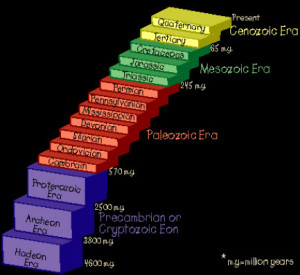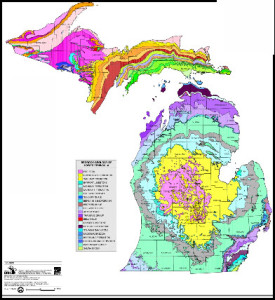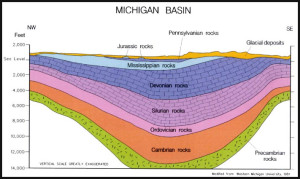Note: This is the second of two posts dealing with the geologic history of Clare County, Michigan, USA.
If you like warm, you should have lived in Clare County, Michigan about 360 million years ago (about 5.6 miles away on our long yardstick in which 1,000 years equals 1 inch and we are at one end). Back then, our county (all of North America as a matter of fact), was nearer to the equator. That’s when the continents were one big happy lump and before the tectonic plates, including the one on which we ride separated, with ours moving slowly but steadily north until it arrived at its present location. It’s still moving and will probably be someplace even colder in the future, but don’t run out and buy a new coat just yet. You may not need it for another 360 million years.

As to our county, it wasn’t in its present condition when it did arrive here. That’s because the glaciers that shaped it and put down all the debris (glacial till) that formed our hills, valleys, plains and such were still far in the future (see Part 1 of this blog post).
However, we were in a valley back then, well it was—and is—more of a basin and it bears the name the “Michigan Basin.” We lie near the middle of the basin and the bedrock that is the underlying formation, is nearly 16,000 feet below us. The basin is deepest in the middle of our state and then gradually tilts upward the surface forming a rim. The basin covers an area of about 119,000 square miles and is visible in various areas including parts of the western Upper Peninsula. The bedrock, which forms the basin, is made of igneous rock meaning that it was molten at one time. The formation of the Michigan Basin goes back about 2.5 billion years (or 40 miles on our really long yardstick) when geologic pressures deep underground caused the rock to be twisted into its present shape.

There is not 16,000 feet of glacial till between us and the bedrock though. That’s because many times in the distant past–long before the glaciers–Clare County was under water. Salt water and lots of times. According to an article from Michigan State University on the Michigan Basin, inland seas covered Michigan during what was termed the Devonian period, a period of about 60 million years that started about 450 million years ago (that’s only 7 miles away on our yardstick). The Devonian period was pre-dinosaur, by the way with most of earth’s creatures living in the oceans (although there were spiders, millipedes and insects scurrying about on the land, which might explain why the ocean’s inhabitants were slow to move out of the water and up onto the land).
At times the seas were clear supporting a variety of shellfish; at other times the seas were muddy with great quantities of silt and decaying vegetation. At other times, the seas contained minerals or were more like huge swamps.
The sediments of each sea compacted to rock (sedimentary). As each layer of sediment was laid down, the basin became shallower. Such things as Clare County oil fields and Saginaw County coal and salt mines, and Alpena County’s limestone quarries, are testament to those ancient seas and the sediment they left behind. Core samples taking during drilling is one way we’ve learned what lies beneath.

The glaciers wiped out any record of the dinosaurs. Our records kind of ends with the Pennsylanian era, although, as the graphic at left shows, we do have a few areas of Jurassic rocks. But no dinosaurs.
There are other fossils, though. Petoskey stones, which are fossilized coral, are the most widely known and are the official Michigan State Fossil. Although we don’t have an abundance of these fossils in our county, the glaciers did drop some in their wake. There are also a large number of others from the Devonian seas that can be found. These include both plants and marine animals, with the latter including clams, corals, crinoids, trilobites, fish and more. (An interesting day can be spent around a quarry or roadside just what the glaciers dropped. There is almost always an assortment of beautiful stones and interesting fossils to be found–if one looks close enough. Be courteous of private property, however.)
There’s also traces of gold and silver in Clare County. Sorry, no veins of gold, just trace amounts that were scoured off gold-bearing rocks in Canada and maybe the Upper Peninsula and dropped here. Of course, there’s always the chance that the glaciers dropped some golf ball-sized nugget somewhere in the county just waiting to be discovered. We can only hope.
Oh, one more thing, among the rocks in Clare County there might be a meteorite or two. None has ever been reported in this county, but one was found two were found not too far away. One in Reed City found in 1895 and one in Kalkaska in the late 1940s. Both found by farmers working their fields.
So, keep your eyes peeled. You never know what cool things this county has in store just waiting to be discovered.
(Writer’s Note: Please let me know if any of my information is not clear or in error. I like geology and wanted to keep this brief and easy to read but I also want it correct.)

